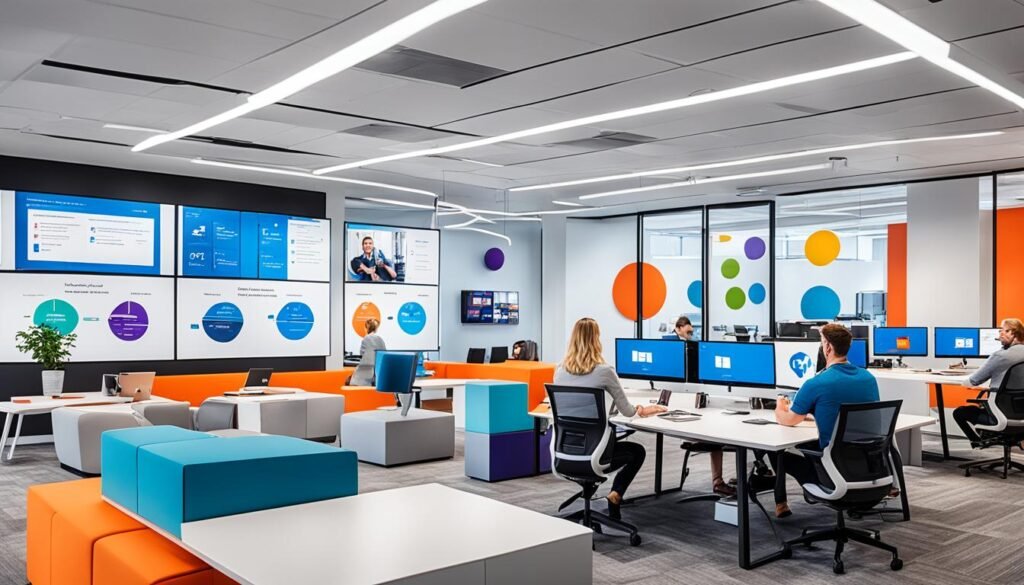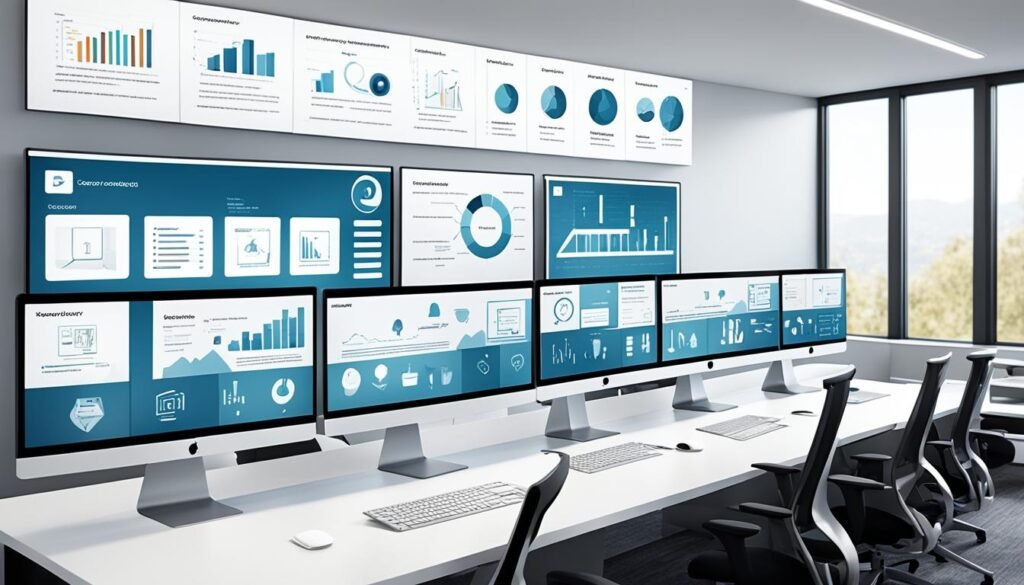In today’s modern workspace, effective communication is crucial for success. The use of technical communication tools has become essential in streamlining connections and enhancing collaboration in both remote and hybrid work environments. These tools not only improve workplace productivity but also promote employee engagement and create a healthy workplace environment.
Key Takeaways:
- Technical communication tools play a vital role in modern work environments.
- These tools streamline connections and enhance collaboration.
- They improve workplace productivity and employee engagement.
- Technical communication tools contribute to a healthy workplace environment.
- Implementing these tools is crucial for success in remote and hybrid work environments.
The Importance of Internal Communication in the Workplace
Effective internal communication is crucial for creating a thriving workplace environment and fostering employee engagement. It serves as the foundation for building strong team collaboration and ensuring the smooth flow of information within an organization.
However, there are often barriers that can hinder effective internal communication. These barriers can include a lack of clarity in communication, hierarchical structures that discourage open dialogue, and misalignment of goals and objectives. Without proper communication, teams may struggle to work cohesively, leading to delays, misunderstandings, and decreased productivity.
Investing in workplace communication tools can help overcome these barriers and improve internal communication processes. These tools provide platforms for seamless and efficient communication, enabling employees to share ideas, receive feedback, and collaborate effortlessly.
Benefits of Effective Internal Communication
When internal communication is prioritized and facilitated through the use of appropriate tools, it brings several benefits to the workplace:
- Enhanced Employee Engagement: Clear and open lines of communication help employees feel valued and involved in the decision-making process. This fosters a sense of engagement and commitment to the organization.
- Improved Workplace Environment: Effective internal communication promotes transparency, trust, and a positive work culture. It encourages open dialogue, reduces conflicts, and builds stronger relationships among team members.
- Increased Productivity: When communication barriers are addressed, employees can collaborate more effectively, leading to streamlined workflows and improved productivity.
- Better Team Collaboration: Through efficient internal communication, teams can establish clear objectives, share information, and work together towards common goals. This fosters a culture of collaboration and innovation.
To illustrate the importance of internal communication in the workplace, consider the following quote:
“Effective communication is the glue that holds an organization together. It enables employees to work together towards shared goals, builds trust, and ensures everyone is moving in the same direction.” – Richard Branson, Founder of Virgin Group
Benefits of Implementing Workplace Communication Tools
Implementing workplace communication tools offers numerous benefits for organizations. These tools provide a centralized platform for team communication, enabling seamless collaboration and efficient workflow management. By utilizing these tools, managers and team leaders can easily track work progress, set goals, and assign projects, ensuring everyone stays on the same page.
One notable advantage of workplace communication tools is their ability to ensure data security. With end-to-end encryption, sensitive information shared on these platforms remains protected, minimizing the risk of data breaches. This level of security is crucial in today’s digital landscape where data privacy is paramount.
Workplace communication tools also serve as a one-stop-shop for organizing and accessing information. Instead of searching through scattered channels, emails, or documents, employees can easily find what they need within the platform. This feature not only saves time but also enhances productivity by streamlining information retrieval.
Moreover, the implementation of workplace communication tools contributes to employee engagement. By providing a platform for open and transparent communication, these tools foster a sense of belonging and strengthen team dynamics. Employees feel valued when their ideas are heard and acknowledged, leading to increased motivation and job satisfaction.
Overall, workplace communication tools play a crucial role in driving productivity, enhancing collaboration, and creating a positive work environment. With their ability to centralize communication, ensure data security, and promote employee engagement, these tools are essential for organizations striving for success in today’s fast-paced and interconnected business landscape.
Top 10 Internal Communication Tools for Streamlining Work
When it comes to improving internal communication and streamlining work processes, there are several powerful tools available in the market. These tools not only facilitate seamless communication but also enhance collaboration among team members. One highly recommended tool in this regard is ClickUp, an all-in-one project management and productivity platform that offers a wide range of features to support effective internal communication and collaboration.
Here are the top 10 internal communication tools that can transform your workplace:
- ClickUp: ClickUp provides a comprehensive solution for internal communication, with features such as collaboration detection, real-time collaboration, digital whiteboards, document collaboration, messaging, screen recording, and email integration. With its user-friendly interface and versatile functionality, ClickUp is an ideal tool for remote teams and organizations looking to enhance team communication and collaboration.
- Slack: Slack is a popular messaging and collaboration platform that allows teams to communicate in real time. With its channels, audio and video calls, and app integrations, Slack provides a seamless communication experience for team members.
- Microsoft Teams: Microsoft Teams is a communication and collaboration platform that integrates well with the Microsoft Office 365 suite. It offers video calls, group chats, internal and external communications, breakout rooms, and features like Together Mode and Presenter Mode.
- Trello: Trello is a visual project management tool that helps teams organize and prioritize tasks. With its intuitive interface and customizable boards, Trello enables transparent communication and effective collaboration within teams.
- Asana: Asana is another popular project management tool that aids in streamlining workflows and improving team collaboration. It allows teams to track progress, assign tasks, and communicate effectively, making it a valuable tool for internal communication.
- Google Workspace: Google Workspace offers a suite of collaboration tools—including Gmail, Google Drive, Google Docs, and Google Calendar—that facilitate communication and collaboration within teams. With its cloud-based approach, Google Workspace allows for real-time document collaboration and seamless communication.
- Zoom: Zoom is a video conferencing and communication tool that has gained popularity, especially in remote work settings. It enables teams to connect face-to-face, conduct meetings, and collaborate effectively, regardless of geographical locations.
- Monday.com: Monday.com is a team management platform that offers features for task management, project tracking, and internal communication. It provides a centralized hub for teams to collaborate, communicate, and stay updated on project progress.
- Basecamp: Basecamp is a project management and internal communication tool that emphasizes simplicity and collaboration. It offers features like message boards, to-do lists, file sharing, and scheduling, making it a valuable asset for teams.
- Notion: Notion is an all-in-one workspace that combines notes, tasks, wikis, and databases. With its flexible structure and collaborative features, Notion enhances communication and collaboration among team members.
These are just a few examples of the wide range of internal communication tools available. Depending on your organization’s needs and preferences, you can choose the tool that best suits your requirements. Implementing a robust internal communication tool can significantly improve team collaboration, boost productivity, and streamline work processes.

Enhancing Team Communication with Slack
Slack is a popular communication platform that offers a wide range of features designed to enhance team communication and collaboration. With its instant messaging capabilities, workplace collaboration tools, and seamless integrations, Slack provides organizations with an efficient and effective means of communication.
One of the key features that sets Slack apart is its use of channels, which allows users to organize conversations by project or topic. This feature enables teams to have focused discussions and ensures that information is easily accessible to everyone involved. Whether it’s brainstorming ideas, sharing updates, or providing feedback, channels in Slack streamline communication and foster collaboration among team members.
In addition to channels, Slack also offers audio and video call capabilities, allowing teams to connect and collaborate in real-time. This feature is particularly useful for remote or geographically dispersed teams, as it eliminates the need for lengthy email threads and provides a more personal and efficient form of communication.
Furthermore, Slack’s app integrations make it a versatile messaging software. It seamlessly integrates with various tools and platforms that teams use on a daily basis. Whether it’s project management software, file-sharing tools, or document collaboration platforms, Slack’s app integrations ensure that teams can access all their necessary tools within one centralized platform.
Benefits of Using Slack for Team Communication:
- Efficient instant messaging for quick communication
- Channels for organized and focused discussions
- Audio and video calls for real-time collaboration
- App integrations for seamless workflow
- Enhanced collaboration and productivity
Overall, Slack is a robust communication platform that provides instant messaging, workplace collaboration tools, audio and video calls, app integrations, and more. Its user-friendly interface and comprehensive features make it an excellent choice for teams looking to enhance their communication and collaboration.

Microsoft Teams for Hybrid Work Environments
Microsoft Teams is a comprehensive communication tool that caters to the evolving needs of hybrid work environments. With its wide range of features and seamless integration with Microsoft Office 365, Teams offers an all-in-one solution for effective collaboration and communication.
One of the key advantages of Microsoft Teams is its ability to facilitate video calls and group chats. This enables teams to connect and collaborate in real-time, regardless of their physical location. Whether conducting team meetings or discussing project updates, Teams provides a platform for face-to-face interactions, fostering a sense of connection and engagement among team members.
Furthermore, Teams supports internal communications within organizations. It serves as a centralized hub where employees can share information, exchange ideas, and collaborate on various projects. The integration with Microsoft Office 365 allows for seamless document sharing and co-authoring, enhancing productivity and streamlining workflows.

Another noteworthy feature of Microsoft Teams is the availability of breakout rooms. These rooms are particularly useful for larger meetings or workshops, as they allow participants to work in smaller groups and then reconvene to share their ideas and insights. Breakout rooms promote active participation, collaboration, and problem-solving.
Teams also offers unique features such as Together Mode and Presenter Mode. Together Mode creates a virtual shared space where participants feel as if they are in the same room, enhancing the sense of connection and fostering more engaging meetings. Presenter Mode, on the other hand, allows presenters to deliver their content more effectively, with features like screen sharing and slide annotations.
In addition to internal communications, Microsoft Teams facilitates external communications as well. Users can easily invite external guests to join meetings, enabling seamless collaboration with clients, partners, and stakeholders. This functionality expands the reach of Teams beyond the organizational boundaries, ensuring effective communication and collaboration with external stakeholders.
In summary, Microsoft Teams is a powerful communication tool designed to meet the demands of hybrid work environments. With its extensive features such as video calls, group chats, breakout rooms, and integration with Microsoft Office 365, Teams enables seamless communication and collaboration among remote and on-site teams. By leveraging the capabilities of Microsoft Teams, organizations can enhance productivity, foster collaboration, and create a cohesive and connected workforce.
Workplace Technology and Its Role in Hybrid Work
Workplace technology plays a crucial role in supporting the hybrid work model, where employees have the flexibility to work both remotely and on-site. By leveraging collaboration and communication solutions, work and project management tools, calendar solutions, payroll systems, digital workspace scheduling systems, cybersecurity tools, document sharing and management applications, and time tracking and productivity monitoring solutions, organizations can ensure effective communication, seamless collaboration, and increased productivity in a hybrid work environment.
The use of collaboration and communication solutions enables teams to stay connected regardless of their physical location. Platforms such as Microsoft Teams and Slack provide features like instant messaging, audio and video calls, and project-based channels, facilitating real-time communication and effective collaboration among team members, whether they are working remotely or in the office.
Work and project management solutions streamline workflows and help teams stay organized. Tools like ClickUp and Asana allow for task assignment, progress tracking, and project management, ensuring that everyone is on the same page and deadlines are met. They also provide a centralized platform for collaboration, document sharing, and feedback, promoting efficient teamwork in a hybrid work setting.
Calendar solutions, such as Google Calendar and Outlook, simplify scheduling and help employees manage their time effectively. With these tools, team members can easily schedule meetings, share availability, and avoid conflicts, ensuring smooth coordination and communication among team members in different locations.
Payroll solutions automate payroll processes and ensure accurate and timely salary payments to employees. These tools eliminate manual calculations and reduce the chances of errors, allowing HR and finance teams to focus on other essential tasks and maintain employee satisfaction and trust.
Digital workspace scheduling systems, like Robin and Teem, optimize office space utilization. They enable employees to reserve meeting rooms, workstations, and other resources, ensuring the availability of the necessary workspace when employees choose to work on-site. These systems also provide insights into space usage, helping organizations make informed decisions about office layouts and resource allocation.
Cybersecurity tools play a critical role in safeguarding sensitive data in a hybrid work model. Solutions like antivirus software, firewalls, and secure VPN connections protect against cyber threats, ensuring the security and integrity of digital assets and communications.
Document sharing and management applications, such as Google Drive and Microsoft OneDrive, facilitate seamless collaboration and version control. These tools allow employees to create, edit, and share documents in real-time, ensuring that everyone has access to the latest information and fostering efficient teamwork across different locations.
Lastly, time tracking and productivity monitoring solutions, like Toggl and RescueTime, help employers monitor and analyze employee productivity in a hybrid work environment. By tracking the time spent on tasks and providing insights into productivity levels, these tools enable organizations to identify areas for improvement, optimize workflows, and foster a culture of accountability.
Overall, workplace technology solutions empower organizations to overcome the challenges posed by the hybrid work model. By leveraging these tools, businesses can ensure effective communication, collaboration, and productivity, regardless of where their employees choose to work.
Benefits of Effective Communication in the Workplace
Effective communication in the workplace offers numerous benefits. It plays a crucial role in conflict resolution, helping teams navigate disagreements and find mutually beneficial solutions. By promoting open and honest dialogue, effective communication can prevent conflicts from escalating and maintain positive working relationships.
Furthermore, effective communication enhances public relations by ensuring that organizations convey their messages clearly and consistently. It enables businesses to effectively communicate with clients, stakeholders, and the public, building trust and fostering goodwill.
Innovation and skill development also thrive in an environment of effective communication. When individuals freely express their ideas and opinions, creativity flourishes, leading to new and innovative solutions. Additionally, effective communication facilitates knowledge sharing and collaboration, allowing employees to learn from each other and develop their skills.
Job satisfaction and employee loyalty are closely tied to effective communication. When employees feel heard and valued, they are more likely to be engaged and satisfied in their roles. Effective communication also promotes transparency and trust, creating a positive work environment where employees feel comfortable expressing their thoughts and concerns.
Productivity is another significant benefit of effective communication. Clear and concise communication minimizes misunderstandings and reduces errors, ensuring that tasks are completed accurately and efficiently. By promoting effective collaboration and information sharing, communication also streamlines processes and fosters productivity.
Lastly, effective communication builds a culture of teamwork and trust within the workplace. When employees can communicate openly and respectfully, they feel connected and supported, leading to stronger teams and better outcomes.
“Effective communication is the cornerstone of any successful workplace. It enables us to resolve conflicts, foster innovation, and build strong relationships.”
By fostering effective communication, organizations can create a positive work environment that enables conflict resolution, supports public relations efforts, fosters innovation and skill development, increases job satisfaction and employee loyalty, boosts productivity, and builds a culture of teamwork and trust.

| Benefits of Effective Communication in the Workplace |
|---|
| Conflict resolution |
| Improved public relations |
| Innovation and skill development |
| Increased job satisfaction and employee loyalty |
| Boosted productivity |
| Enhanced teamwork and trust |
Strategies for Improving Workplace Communication
Improving workplace communication is essential for fostering a productive and harmonious work environment. By implementing effective strategies and techniques, leaders can enhance communication within their teams and promote a culture of clear and open dialogue. Here are some key strategies to consider:
- Active Listening: Encourage active listening among team members to ensure that everyone feels heard and understood. This involves giving your full attention to the speaker, asking clarifying questions, and showing empathy.
- Clear Communication: Foster clear and concise communication by using simple language, avoiding jargon or technical terms, and providing context when necessary. Clearly articulate your thoughts and ideas to avoid misunderstandings and confusion.
- Re-stating and Clarifying Information: After receiving information, re-state and clarify it to confirm understanding. This helps to ensure that everyone is on the same page and minimizes the risk of miscommunication.
- Understanding Communication Styles: Recognize that individuals have different communication styles and preferences. Take the time to understand and adapt to these styles, whether it’s through written communication, face-to-face conversations, or using different mediums.
- Open-Mindedness: Foster an environment of open-mindedness where everyone is encouraged to share their thoughts and ideas without fear of judgment. Embrace diverse perspectives and encourage constructive feedback to promote collaboration and innovation.
By implementing these strategies, organizations can lay the foundation for effective workplace communication, positively impacting teamwork, productivity, and overall success.
“Open communication is the lifeline of any relationship, including those within the workplace.” – Brian Tracy
Remember, effective communication is a continuous practice that requires commitment and effort from all team members. By actively applying these strategies, teams can create a communication culture that fosters understanding, collaboration, and success.

| Strategy | Description |
|---|---|
| Active Listening | Encourage attentive listening, asking questions, and showing empathy. |
| Clear Communication | Use simple language, avoid jargon, and provide context to ensure clarity. |
| Re-stating and Clarifying Information | Repeat and clarify key information to confirm understanding. |
| Understanding Communication Styles | Recognize and adapt to different communication styles and preferences. |
| Open-Mindedness | Promote a culture that embraces diverse perspectives and constructive feedback. |
Helpful Communication Tools for the Workplace
Effective communication is the backbone of a successful workplace. To facilitate seamless communication and enhance collaboration, organizations can utilize various workplace communication tools. These tools cater to different aspects of communication, including video communication, meeting scheduling, messaging apps, workflow management, and collaboration software. By leveraging these tools, businesses can streamline communication processes, improve productivity, and foster collaboration within their teams.
1. Video Communication Platforms
Video communication platforms provide real-time visual interaction between team members, regardless of their physical location. These tools enable face-to-face communication, making it easier to convey messages, share ideas, and collaborate on projects. Popular video communication platforms include:
- Zoom
- Microsoft Teams
- Google Meet
2. Meeting Scheduling Software
Meeting scheduling software simplifies the process of organizing and managing meetings. These tools offer features such as automated scheduling, calendar integration, and reminder notifications, ensuring that teams stay organized and never miss important meetings. Some commonly used meeting scheduling software includes:
- Calendly
- Doodle
- Google Calendar
3. Messaging Apps
Messaging apps facilitate quick and real-time communication among team members. These apps allow individuals to exchange messages, share files, and collaborate on projects. Some popular messaging apps used in workplaces include:
- Slack
- Microsoft Teams
- Telegram
4. Workflow Management Systems
Workflow management systems provide a centralized platform for managing tasks, allocating resources, and tracking project progress. These tools help streamline workflows, eliminate bottlenecks, and ensure efficient collaboration among team members. Some widely used workflow management systems include:
- Trello
- Asana
- Jira
5. Collaboration Software
Collaboration software enables teams to work together on documents, projects, and tasks in real time. These tools promote seamless collaboration, version control, and efficient document management. Popular collaboration software includes:
- Google Workspace
- Microsoft Office 365
- Notion
Incorporating these workplace communication tools into daily operations can significantly enhance communication, improve productivity, and foster collaboration within the workplace. By leveraging the right tools, organizations can create a streamlined and efficient work environment where teams can thrive.
The Role of Technology in Supporting Hybrid Work
Technology plays a crucial role in supporting hybrid work environments. It enables workplace connectivity, automates repetitive tasks, enhances communication through dedicated tools, and promotes employee engagement and efficiency. With the right technology in place, businesses can effectively manage remote team communication and streamline workflows.
In a hybrid work setup, where teams are spread across different locations, technology acts as the connective tissue that keeps everyone interconnected. It ensures seamless communication and collaboration among team members regardless of their physical location. Whether it’s through video conferencing platforms or messaging apps, technology provides the means to bridge the gap and facilitate effective remote team communication.
Furthermore, technology simplifies and automates repetitive tasks, freeing up time for employees to focus on more strategic and creative endeavors. By implementing workplace software and automation tools, companies can eliminate manual and time-consuming processes, resulting in increased productivity and efficiency.
One of the key advantages of technology in the workplace is the availability of communication tools specifically designed for professional use. These tools offer features such as instant messaging, project management, and document collaboration, allowing teams to collaborate effectively in real-time and ensuring that everyone is on the same page.
“Technology enables workplace connectivity, automates tasks, and enhances communication, ultimately leading to improved employee engagement and efficiency.”
Moreover, technology promotes employee engagement by providing various platforms and applications that encourage interaction and collaboration. Through these tools, employees can actively participate in team discussions, share ideas and feedback, and contribute to the overall success of the organization.
Efficiency is another significant benefit of technology in the workplace. With the right tools and systems in place, businesses can streamline workflows, minimize bottlenecks, and optimize processes. This not only saves time but also ensures that tasks and projects are completed in a timely manner, enhancing overall efficiency and productivity.
Also Read:- Top Technical Skills For Resumes 2024 | Upgrade Now
Overall, technology plays a pivotal role in supporting hybrid work environments. It fosters workplace connectivity, automates tasks, enhances communication through dedicated tools, and promotes employee engagement and efficiency. By leveraging technology effectively, organizations can create a seamless work experience for their remote and on-site teams, resulting in improved collaboration, productivity, and ultimately, business success.
| Benefits of Technology in Supporting Hybrid Work |
|---|
| Workplace connectivity |
| Automated tasks |
| Enhanced communication through dedicated tools |
| Employee engagement |
| Efficiency |
| Remote team communication |
Conclusion
Effective communication is vital in the modern workplace. By utilizing workplace communication tools, implementing communication strategies, and leveraging appropriate technology, organizations can significantly improve communication and reap various benefits.
Workplace communication tools provide a centralized platform for team collaboration, allowing for streamlined communication and improved productivity. These tools also enhance employee engagement and create a positive work environment.
Implementing communication strategies, such as active listening and clear communication, fosters effective communication within teams. By understanding communication styles and promoting open-mindedness, organizations can overcome barriers and improve overall communication.
By embracing technology in the workplace, businesses can enhance connectivity, automate tasks, and facilitate efficient communication. With the right tools and technology, organizations can effectively manage remote team communication and optimize workflows.
In conclusion, by prioritizing effective communication and leveraging workplace communication tools, technologies, and strategies, organizations can unlock the benefits of enhanced collaboration, increased productivity, and a positive work environment.
FAQs
Q: What are the most essential technical communication tools for modern workspace?
A: The essential technical communication tools for modern workspace include technical writing tools, editing tools, image editing tools, publishing tools, spell check tools, authoring tools, and screen capture tools.
Q: What are some popular tools for technical writing in 2024?
A: Some popular tools for technical writing in 2024 include software tools, right tools for technical writing, best technical writing software, and word processing tools.
Q: How can technical writers benefit from using tools for technical documentation?
A: Technical writers can benefit from using tools for technical documentation by improving their writing and editing processes, creating visually engaging content with image editing tools, and ensuring accuracy with spell check tools.
Q: What are some key features to look for when choosing the right tools for technical writing?
A: When choosing the right tools for technical writing, look for features such as writing and editing capabilities, support for technical documentation, integration with authoring tools, image editing tools, and screen capture tools.
Q: How can technical writers enhance their skills using software tools?
A: Technical writers can enhance their skills using software tools by utilizing writing assistant features, creating technical whitepapers, improving documentation with the best technical writing tools, and collaborating with other technical and content writers.
Q: Are there any free versions of popular tools for technical writing available?
A: Yes, there are popular free online word processors and tools like the snipping tool that offer free versions for technical writers to use in their writing and editing processes.
Q: What are some examples of software documentation tools widely used by technical writers?
A: Examples of software documentation tools widely used by technical writers include tools for creating technical documents, software documentation, tool for technical writers, and one of the best technical writing software tools.
Source Links
- https://www.yarooms.com/blog/5-must-have-tools-in-your-hybrid-workplace-technology-stack
- https://clickup.com/blog/workplace-communication-tools/
- https://www.ringcentral.com/us/en/blog/the-importance-of-effective-communication-in-the-workplace/

